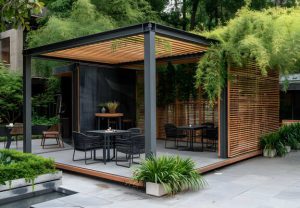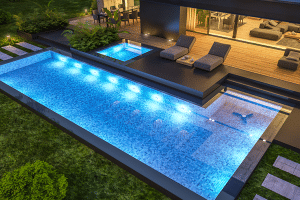A garden reticulation system is nearly ubiquitous with living in Perth. Our hot, dry summers mean that relying on natural rainfall just doesn’t cut it. Some people hand water, but most people don’t have a spare few hours to hand-water their gardens every week. So, most of us rely on reticulation systems to water our lawn and gardens for us. A reticulation system is (at the most basic level) a network of pipes installed throughout an area to deliver water to the garden and lawns through “sprinklers” (outlets that spray water over the area).
Most systems in Perth are automatic and either work on potable water (mains drinking water) or from a water bore.
Just like anything else, reticulation systems require regular upkeep to continue to operate effectively. One of the most common problems that will occur is sprinklers’ breaking. When this happens – not only will this sprinkler nozzle now not cover its designated area, often it will be losing a flood of water, causing the other sprinklers on that station or zone to lose pressure.
Sprinklers break for a variety of reasons:
- In lawns, the most common culprit is the lawnmower or whipper snipper.
- For verge lawns, it’s usually cars driving over them and breaking them.
- In gardens, sprinklers can often snap due to people or pets knocking into them or if a plant grows too large and pushes it over.
- In general, sprinklers can get blocked up with sand/debris or fail due to simple wear and tear.
All sprinklers are susceptible to blocking up (especially if cheaper nozzles are used) or if the system has sand or debris in the water (like most water bores in Perth).
How to Repair Damaged Sprinklers
Lawn Sprinklers
Lawn sprinklers are usually a special type of sprinkler called a ‘pop-up’ sprinkler. The pop-up sprinkler has a plastic ‘body’ and a ‘shaft’ that pops up from inside the body. These sprinklers rely on water pressure to pop up and a spring inside the body retracts the shaft when watering finishes. These are installed below the ground to pop-up when that station turns on, leaving your lawn unobstructed.
If the nozzle is blocked, simply lift the shaft using a sprinkler clamp tool and unscrew the nozzle anti-clockwise. Flush that station and then replace with a new nozzle.
If the shaft is sticking up and stuck, then there is likely sand between the shaft and pop-up body. Excavate around the pop up until you get to the fitting at the bottom of the pop-up body that connects it to the lateral pipework. Dig down another 5cm or so and ensure the area around the pop up is clear of dirt, some residual water is going to come out of the sprinkler and pipework when you take it off. You don’t want dirt getting back into your pipework and blocking sprinkler nozzles. Then unscrew the pop up from the fitting by turning anti-clockwise. You can now take the pop-up body apart by unscrewing the cap from the pop-up body. Inside you will find a spring, wiper seal, and in some higher quality models a check valve. Wash all components under a garden tap and re-assemble. Re-install the pop up and test. If it’s still temperamental, the pop-up is probably damaged and will need replacing.
If the pop up itself is broken, then you will need to replace it with a new model. Our recommendation is always use at least a 100mm pop up. We also recommend you use an articulated riser (sometimes called a swing joint) or funny tube (also known as silly tube), to connect your pop up to the lateral pipework. The use of an articulated riser or funny tube has two key benefits compared to screwing the pop up straight into the lateral pipework with a nipple or flexi riser.
Firstly, they protect the lateral pipework from impacts to the sprinkler body. If a car drives over a traditional set up (pop-up installed into lateral pipework with a nipple) then the force will generally transfer down through the stronger plastic of the pop up into the weaker PVC pipework below, causing it to crack. This is frustrating and time consuming to fix. On the other hand, the use of an articulated riser prevents this force transferring and usually provides some cushioning for the sprinkler itself too. Even if the articulated riser or pop up itself breaks, it’s a much easier and quicker fix.
The second clear benefit is that by using an articulated riser or funny tube, you can adjust the height of the pop up easily without being dictated by the height of your lateral pipework. This makes installation quicker and maintenance easier. Find that after a couple years your lawn has built up a few centimeters and your pop ups are too low? With an articulated riser it’s no problem to just raise up each one!
Garden Sprinklers
There is a wider variety of sprinklers found in gardens than in lawns, for example:
- Some systems use fixed sprays on risers to cover the whole garden.
- Other systems will use drippers or “shrubblers” (small sprinklers that throw out a dinner plate spray of water) at the base of each plant.
- Many systems will have a type of irrigation called “dripline”, a network of subsurface pipes with dripper holes every 15-30cm for blanket area coverage.
For the purposes of this article, we will just be looking at fixed sprays as these are the most commonly broken garden sprinklers. You will find there are two main problems with fixed sprays. Either the nozzle itself is damaged or blocked, or the riser is snapped.
For a blocked or damaged nozzle either replace with a new one or you can attempt to clean out under a garden tap.
For a damaged riser simply replace with a new one. Sometimes the threaded end of the riser will get stuck inside the lateral pipe fitting and you’ll need to use a “riser removal tool” to get the broken bit of threaded riser out of the fitting. All good irrigation stores will stock these.
The Importance of Matched Precipitation
One last important thing, for each station or zone (either in the lawn or garden), you want to ensure that the sprinkler nozzles being used have something called Matched Precipitation. This means that as a general rule, you need to use the same make and model of nozzle on any given station. This is because different nozzles have different flow rates, and this can vary wildly. A Hunter MP Rotator uses about four times less water per minute than a Rain Bird MPR Fixed Spray nozzle. If you mix and match these, you’re either going to underwater with your MP Rotators or overwater with your Rain Bird Fixed Sprays.
Some sprinklers from a different make or model may have the same flow rate such as the Rain Bird R-VAN’s and the Rain Bird 5000 Series Gear Drive Rotors. However this is usually not the case and is an exception to the rule.
Leave all nozzles off once the pop ups and risers have been re-installed.
Ensure any new pop-up shafts are lifted up using your sprinkler clamp tool from earlier. Then remove the flushing cap and turn on the station for at least 20 seconds. You can rub your forefinger and thumb together in the water spout to feel if any grit is coming out. When it runs clear turn off the station and then install the new nozzle.
To adjust the direction of flow you will need to crank the shaft of the pop-up to get the right angle. Sometimes you’ll need to do this while the system is on to ensure you’ve got the sprinkler on the right angle, and you’ll probably get soaked at this stage.
If you’re using adjustable nozzles, then always line up the edge of the arc on the left-hand side because they all open up to the right. Once you’ve lined it up using the shaft you’ll need to adjust the nozzle to open up the arc. Different brands have different ways of doing this so make sure you refer to the manufacturer’s instructions here.
Do a final test and walk around of your system to ensure everything is working well, and that’s it! Remember to check your system regularly. We recommend servicing your sprinkler system at least every 6 months for best results.
Who should I contact for help?
The professional team at Luke’s Landscaping Co. can handle every aspect of your project. Why risk doing it wrong?
Need Us To Help With Your Garden?
NEED US TO HELP WITH YOUR GARDEN?








